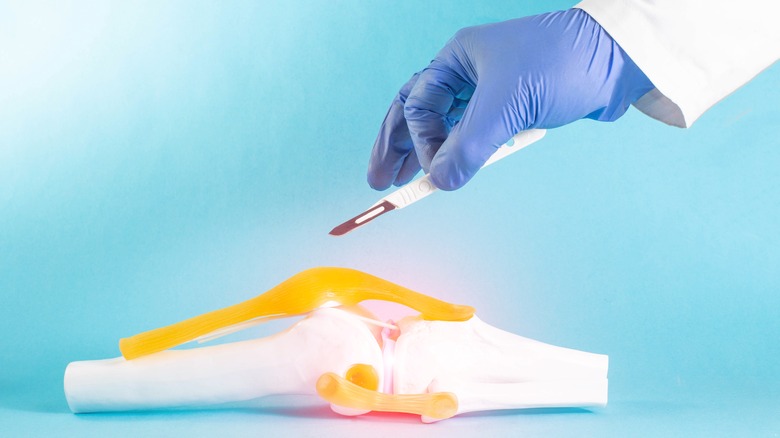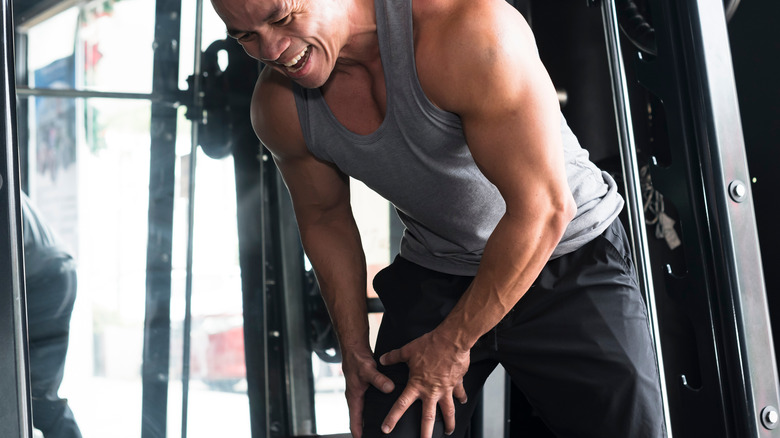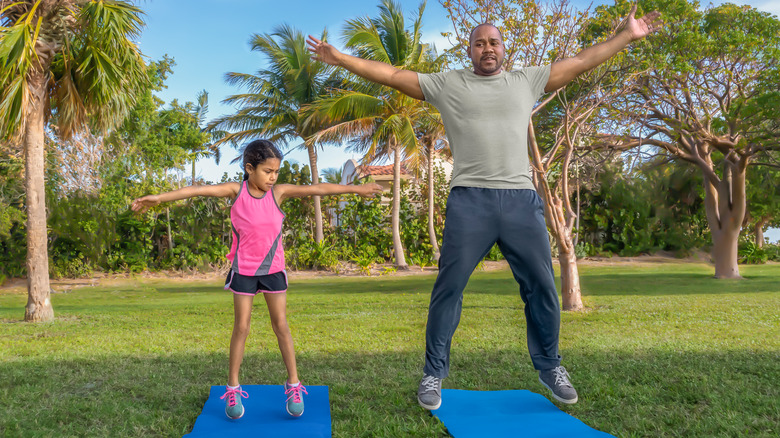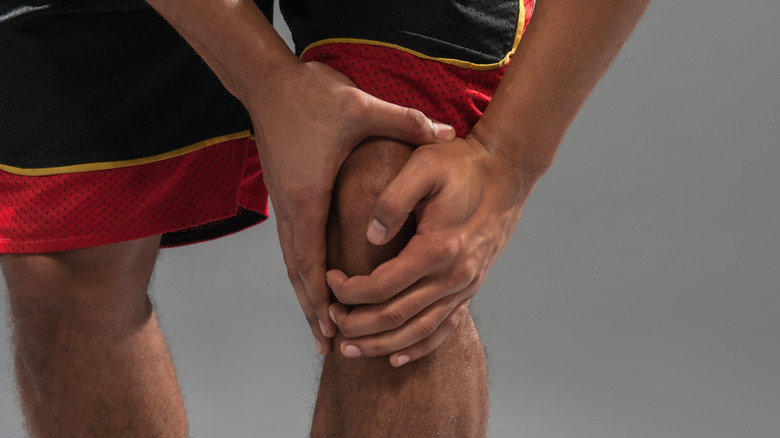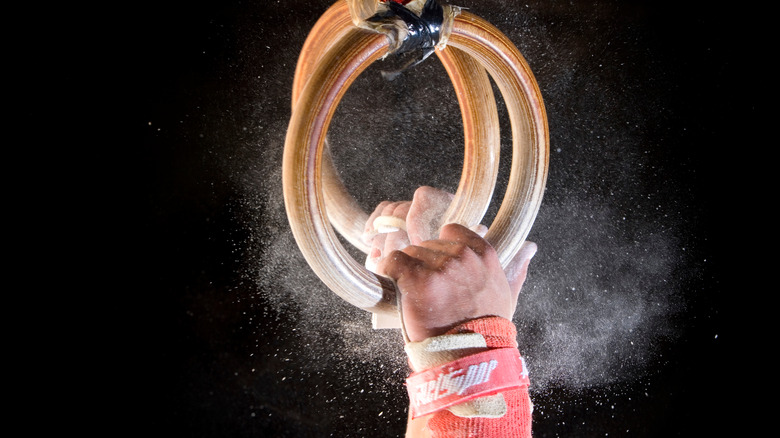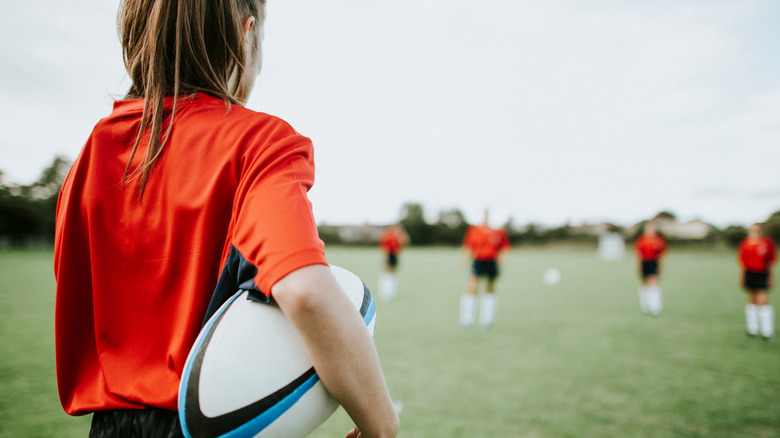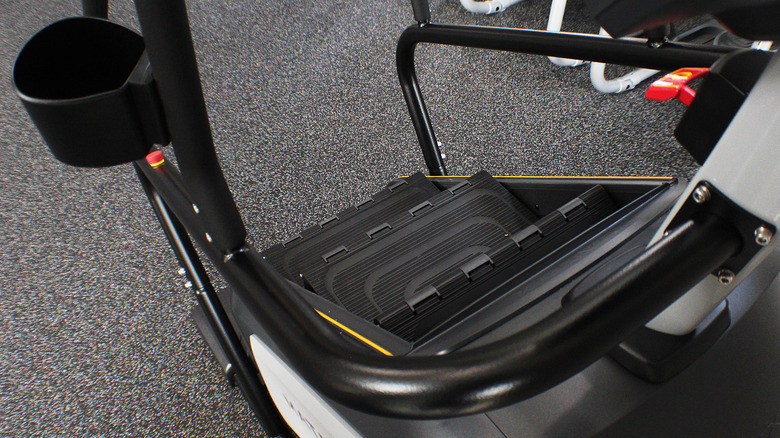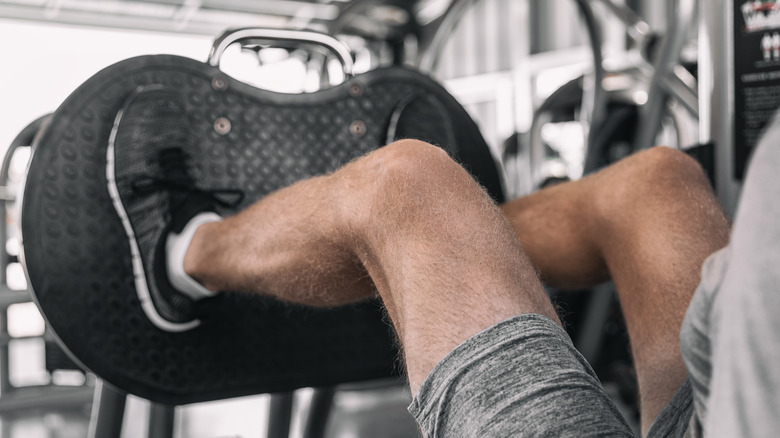Exercises You Should Never Do After Getting A Knee Replacement
Our knees go through a lot in our lifetimes. With the joints involved in pretty much every step, jump, and turn we take, over the years, our knees can start to get less mobile and able to complete everyday tasks. And for some people, particularly individuals who have osteoarthritis, a knee replacement may be the only solution to restore mobility and function.
Knee replacements are far from uncommon. In the U.S. alone, around 1,000,000 knee replacements are performed yearly — and that number is only likely to rise, according to researchers from Northwestern University's Feinberg School of Medicine in Chicago (via WebMD). And for folks recovering from knee replacements, understanding how you can bounce back to full health and partake in activities like exercise again is crucial for physical health, general wellbeing, and naturally, protecting your replaced knee.
But as with a lot of things in life, there are a lot of different opinions out there about which exercises are okay to do after a knee replacement. So, once and for all, let's identify the exercises you definitely shouldn't be doing after undergoing the procedure.
Jogging after a knee replacement may be a bad idea
Let's face it: Jogging, and running, involve your knees a lot. When your knees are fully functional, this may not be the worst thing in the world, with running actually proving beneficial for the joints in some cases (per Healthline). But immediately after you've had a knee replacement, jogging is an exercise you should be doing very carefully, if at all. As a high-impact exercise, jogging and running can stress your knee joint quite significantly when it's in recovery, and so they're best avoided, says the American Academy of Orthopaedic Surgeons.
But the question is: For how long? Is jogging completely off the cards if you have a knee replacement, forever? Not necessarily, according to Sports Injury Physio. Research published in Orthopaedics & Traumatology: Surgery & Research demonstrated that individuals were still able to run long distances (and even ultra-marathons) following a knee replacement. Fundamentally, though, it's important to be very cautious if you're thinking of returning to jogging following a knee replacement, due to a lack of extensive research about how doing the exercise could impact the knee joint. If you're planning on running again, make sure you talk it through with your surgeon first.
Lay off the squats at the gym
If you're a fan of squats, you may be disappointed to hear that they may be slightly less appealing after a knee replacement. While squats themselves may not be bad for your knees, the movement puts a fair amount of stress on the joint, according to Exercise & Sports Science Australia. When your knees are fully functional, this may not be a massive issue. But once you've had a knee replacement, you might find it more difficult to perform full squats, and it may also be uncomfortable to do so, per the experts at St. Vincent's Hip & Knee Surgeons.
Half squats, on the other hand, may still be possible to perform, and could provide some leg-strengthening benefits that can protect your knee joint by building up the muscles around them. Also, bear in mind that while full squats may remain off-limits, other weightlifting and resistance exercises could be beneficial following a knee replacement, as they can help improve bone density and generally prolong your new knee's life (per Beacon Orthopedics & Sports Medicine).
Whatever you do, though, make sure your form is on point: The last thing you want is to injure yourself due to improper movement and risk your knee replacement's health.
If you're a fan of jumping jacks, you won't be after a knee replacement
Jumping jacks are the go-to exercise for millions of people around the world, for a quick and simple way to get the ol' heart pounding. Unfortunately, though, once you've had a knee replacement, it may be one of the worst exercises you can do.
While we're loathe to state the obvious, jumping jacks involve a lot of jumping. "Jumping jacks are high-impact plyometrics. Every jump and land places a magnitude of our own bodyweight through the foot, ankle, knee, hip, and spine," says personal trainer Nick Occhipinti (via Greatist). And all of that impact can create some serious stress through your knee. That's why veering towards low and medium-impact activities, and not ones that involve jumping, are generally recommended for people who have undergone knee procedures, according to research published in BMJ Open Sport & Exercise Medicine.
Having said this, if you're still keen on performing jumping jacks, a low-impact version is entirely possible, as Greatist shows. Simply remove the jump in the middle; instead, alternate kicking each leg out to the side and tapping it on the floor at full extension beside you while keeping your arms mobile above your head.
Basketball could be one of the worst sports following a knee replacement
Shooting some hoops might have been your idea of a good time before a knee replacement, but after having a knee procedure, that good time could quickly turn sour.
Basketball is one of the absolute worst exercises to do after a knee replacement thanks to its high-impact nature, says the Arthritis Foundation. The continual jumps, twists, and turns that make up vigorous basketball practice can seriously stress your knee joint, and may negatively impact the bond where the bone attaches to the knee implant. The high-impact movement may also wear down the plastic of the new joint faster.
This isn't just the case with basketball, but with all sports that have a significant level of movement through the knee. Exercises like soccer and field hockey, which can have a similar style of movement through the knee, may alter your recovery process significantly, or even cause problems further down the line. Exercises which don't stress the knee out in such a manner and are low-impact (like cycling or using the elliptical) are far more preferable.
Gymnastics isn't a great idea
Few exercises are more impressive than gymnastics, in our opinion. But we're also well aware that gymnastics can bend your body into some pretty extreme positions — and if you've had a knee replacement, it won't thank you for it.
Gymnastics is best avoided after a knee replacement operation, as it's a sport that involves both continual impacts to your knee joint (through landing from jumps and quick sprints) and movements that can twist or yank your knee in difficult directions, according to Healthline. Movements like this can negatively affect your knee replacement.
But never fear! There's another exercise out there where you can get your flexibility fix, without affecting your knee replacement too heavily: yoga. "Yoga may help with flexibility and overall posture, strengthen the muscles around your new joint, provide pain relief and even improve digestion," says nurse practitioner and yoga enthusiast Christine Mironenko (via Hospital for Special Surgery). Yoga may also assist knee replacement patients in managing stress and anxiety following a procedure, as well as encourage better sleep. Just make sure that you're practicing yoga gently; don't twist your body into some of the more advanced poses, as this may hinder your recovery.
Any exercises that involve kneeling should be avoided
After a knee replacement, altering our movements to reduce the impact on the joint should be our top priority, not only for its recovery but for our comfort. And this includes trying to avoid any positions or exercises that involve kneeling.
A large percentage of people struggle with kneeling following a joint replacement, with up to 80% of people either not being able to kneel or finding it difficult to do so, per research published in EFORT Open Reviews. It's for this reason that trying to avoid any exercising that involves kneeling is a good idea, as this will avoid putting further stress on your body. Kneeling exercises are especially common during resistance workouts, with on-the-knees variations of lat pulldowns, overhead presses, and med ball rotational throws (as shown via Muscle & Fitness). All of these are wise to avoid, although these moves can usually be done in a seated position while using an exercise bench. Yoga positions or stretches that involve the knee touching the floor, like kneeling lunges, are also smart to skip.
Skiing might put a significant impact on your knee
There's nothing quite like skiing. The feeling of racing down a mountain with snow flying behind you in perfect arcs is hard to beat. But when you've had a knee replacement, skiing can quickly turn from a dream into a nightmare.
Skiing involves a lot of twisting, turning, and pivoting, which can aggravate your replacement knee joint quite significantly (per NHS Bridgewater Community Healthcare). There's also the falling aspect to consider: Any significant tumble taken on the snow could jerk your knee into unsafe positions.
If you are determined to get back on the slopes, though, it's important to remember that gentle downhill skiing could still be safe. You just have to be pretty careful — and realistic about your limits, too. "You should pick your days and pick your terrain. Soft powder is recommended over icy conditions," explains University of Utah Department of Orthopaedic Surgery faculty member Lucas Anderson (via University of Utah Health), who doesn't shy away from discussing the potential catastrophes that can go wrong on the slopes. "The risk is for someone to slide into a tree or other obstacle and fracture the bone around their new knee, which can cause all sorts of problems."
It's best to stay off the rugby pitch after a knee replacement
Rugby's a great team sport, but it's not without its potential dangers (seriously, you don't have to be a genius to take a look at a fully-packed scrum and realize that it's an environment you could get injured in). And for folks who have had knee replacements, it's probably best to avoid it entirely.
Contact sports like rugby are far less fluid than other forms of exercise, and the jerky movements that a rugby game can involve may destabilize your knee replacement, according to Tri Country Orthopaedics. This can lead to the need for further procedures — and in some cases, a full revision of the knee surgery entirely.
And even if you haven't had a knee replacement, we'd advise being careful on the rugby pitch. In rugby union specifically, knee injuries are by far the most frequent injuries people face, says consultant orthopedic knee surgeon Jonathan Webb (via the Fortius Clinic). ACL and MCL tears can be common, with meniscal tears and further ligament damage also regularly occurring in players.
Certain types of dancing should be avoided — but lighter dancing may be okay
We're just gonna say it: We don't entirely trust people who don't like to dance. Honestly, it's one of life's greatest pleasures. This is why it brings us serious unhappiness to say this next bit: If you've just had a knee replacement, dancing may not come as easily as it once did, and it's important to be careful while doing it. It's especially prudent to avoid any dancing that involves jumping, which can stress and potentially destabilize your knee joint, as well as any twisting or sudden movements (via Healthline).
But before you call us all killjoys and say goodbye to dancing forever, you'll be pleased to hear that you can still throw some shapes on the dance floor. Lighter dance styles like ballroom are still entirely possible, and can provide a good workout while you're doing them. Just ensure that you're doing what you can to prevent stressing your knee joint too heavily. Trying to build strength in your legs to protect your knee joint, wearing suitable footwear, and dancing with form and alignment in mind are all great tips that can help dancers remain healthy, whether they've had a knee replacement or not (per Hip & Knee Orthopaedics).
You'll want to steer clear of the Stairmaster machine until you're fully recovered
Stairmasters are pretty deceptive. In the simple act of climbing up some stairs, you're getting a hugely effective cardio workout, strengthening the entirety of your lower body and your bones, and boosting your mood to no end (per Healthline). But we're pretty sure you won't be as happy if you're trying to do a Stairmaster workout after a knee replacement. Stair stepping exercises can be difficult immediately after knee procedures due to a lack of strength and stability in the area, and can lead to injury, says Livestrong.
Climbing and descending stairs can generally be more difficult following a knee replacement, which is why it's important to take precautions and build back up slowly. When you're climbing upstairs after surgery, hold on to the handrail and use your good knee to push your body up, lifting your replaced knee to join it on each step. Then, on the way down, descend using the opposite legs, with your replaced knee first. Using crutches or a walker can also give you further support when going up a staircase.
Be careful performing leg press exercises after a knee replacement
Leg press exercises and leg press machines can be seriously dangerous for your knees at the best of times. While working out with these pieces of gym equipment can be safe and give your legs a solid workout, setting the weight too high or locking your knees at the top of the movement can injure your knees quickly, says Healthline. As a result, you should be on your guard when doing leg press extensions following a knee replacement.
However, the good news is that when you're performing these exercises with lower weights, they may actually assist your legs in regaining their strength (via Livestrong). Just make sure that you're keeping the weight setting at below 50 pounds, and ideally between 20-40 pounds to begin. Immediately after a knee replacement, it might be worth prioritizing leg strengthening exercises that won't place such potential strain on your knee. Wall squats and glute bridges are all great movements that can tone and rebuild the larger muscles in your lower body, which will then protect the replaced knee joint. For your lower leg, calf raises and step-ups are simple and effective movements to build strength below the knee.
Downhill mountain hiking is a bad idea following a knee replacement
When you're recovering from a knee replacement, walking is one of the best exercises you can do, and hiking might seem like just a natural extension of that. But be careful which direction you're going. Although gentle hiking shouldn't pose any significant problems for the knee, especially when you're walking uphill, walking downhill can produce a lot of pressure on knee joints, according to WebMD. This could lead to potential problems following a knee replacement.
But there's a problem here that we're sure you've spotted, folks: How are you supposed to only hike one way? What goes up must come down, right? Absolutely! But be mindful of your speed, and take any downhill trails very slowly to limit the impact on the replaced joint. It's also important to assess both the difficulty of the trail and what you're taking with you. Ending up on a strenuous hike with huge rocks you have to clamber over with a massive backpack will be far more harmful to your knee than an easy three-mile jaunt across the hills with just a bottle of water.
Rock climbing may not be the best idea in the world
The white-knuckle thrill of rock climbing is hard to beat. But folks who have had knee replacements might want to think twice before they strap their chalk bag to their waist and head to El Capitan.
Although rock climbing is, by definition, a low-impact activity, it's still pretty dangerous for your knees following a replacement, and should thus be avoided (via Healio). Rock climbing can require you to twist your knee into some pretty contorted positions on occasion, and this could jerk or loosen your replaced joint (per Tri County Orthopedics). This isn't just potentially damaging for your knee itself. Think about it: If you're halfway up a rock face and your knee replacement destabilizes, this could quickly become super dangerous.
It's also worth remembering that knee injuries can (and do) occur during climbing, even if your knees are entirely healthy, with meniscus and medial collateral ligament injuries especially common (via Climbing). Strengthening your leg muscles with moves that mimic common climbing positions, like a resisted drop knee with overhead press exercise, can reduce the likelihood of these injuries happening.
What exercises are best after a knee replacement?
It's easy to feel nervous on the exercise front following a knee replacement. But the good news is that there's still a world of workouts available for you to partake in, which you should be able to enjoy with even greater ease after a procedure.
It's important to exercise with any activity's potential impact on the knee in mind, and to favor workouts that are low-impact. "Patients should alternate activities such as power walking and cycling, which place less stress and pressure on the knee," suggests the Switzerland-based Clinik Für Orthopädische Chirurgie orthopedic surgeon Markus Kuster (via WebMD).
Swimming could also be one of the best choices for exercise following recovery, says Healthline. As a non-weight-bearing activity, swimming will place no impact on your replaced joint, and can provide both aerobic and muscle-strengthening benefits. Swimming can also be safe to do just a few weeks after surgery, though it's wise to check with your surgeon exactly how long you should be waiting before resuming normal activity. And remember, exercising is very important following a knee replacement, as it will help your knee muscles to regain their strength and motion (and have you back to an active lifestyle before you know it).
